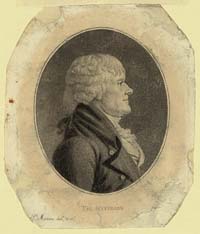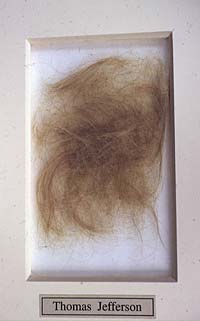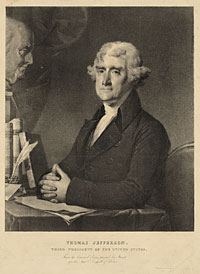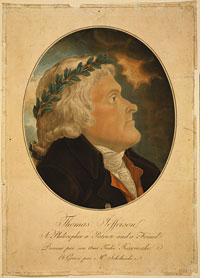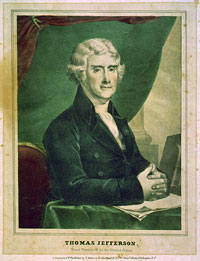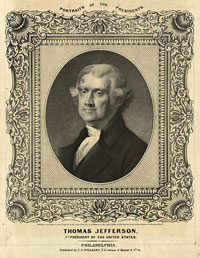Page content
Online Extras
Extra Images
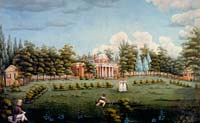
Monticello, Thomas Jefferson Foundation
Not long after Jefferson’s death, Jane Pitford Braddick Peticolas painted this scene at Monticello in 1827 for her friend, and Jefferson’s granddaughter, Ellen Randolph Coolidge, which shows descendants of Jefferson playing on the front lawn.
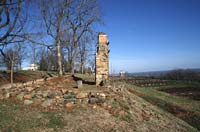
With the main house in the background, the remains of Mulberry Row at Monticello, where the slave quarters were and where Sally Hemings lived before she moved into the servants’ quarters in the South Dependencies on the estate grounds.
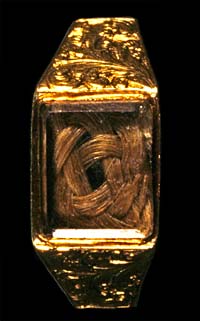
Monticello, Thomas Jefferson Foundation
A braided lock of red hair in a gold ring is one of fifteen hair samples Monticello has that may have belonged to Jefferson.
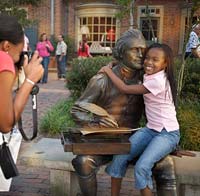
A bronze statue of Thomas Jefferson sits in Williamsburg’s Merchants Square and invites company from passersby.
Hair’s Breadth
Locks could be Keys to
Jefferson Mystery
by James Breig
Metaphorically speaking, historians use wormholes, time tunnels through which they can corkscrew for a look at the past. The portals change, which is one reason biographies and histories are updated. A newly found letter by George Washington, a previously unknown poem by Emily Dickinson, a holograph account book by Henry Ford can hand a researcher a key that unlocks way back then.
Once, those keys were nearly always documents. In the nineteenth century, the arrival of a new technology—photography—offered a new way of glimpsing what happened. Biographies of Abraham Lincoln are richer because authors and readers can study his face, measure his height against that of diminutive General George McClellan, or chart how the Great Emancipator aged during the Civil War. At the beginning of the twentieth century, motion and sound were added to photographs. As a result, stories of sports figures were enlarged because biographers could watch movies of Babe Ruth’s swing, follow the arc of Jack Johnson’s punch, or hear the roar of his fans. An athlete’s quirks and distinctive form did not have to be imagined; they could be witnessed.
The methods of knowing about the past took a quantum leap in 1953 with the discovery of DNA, a double helix of a genetic corkscrew historians and genealogists wielded more and more to bore into mysteries and answer old puzzles. Was a Frenchman who died in the nineteenth century really the son of Louis XVI and Marie Antoinette, as he claimed? Non, said DNA. Is Jesse James buried in Jesse James’s grave? Reckon so, said DNA. Was a twentieth-century woman, Anastasia, the lost child of Russian royalty? Nyet, said DNA. Who was the infant killed in the sinking of the Titanic and buried as unknown? Eighteen-month-old Sidney Leslie Goodwin of England, said DNA.
Advances in the science of DNA and the existence of 200-year-old snips of hair might be able to answer more definitively, and perhaps once and for all, another question that has nagged historians: Did Thomas Jefferson and his slave, Sally Hemings, have children together?
Casual readers might believe the Jefferson-Hemings question was resolved in the affirmative in 1998, when a DNA study was done involving descendants of the Jefferson family and of Hemings. But the DNA evidence by itself proved only that her descendants carry DNA that shows up in the Jefferson family. That leaves an enormous question two words long: Which Jefferson?
The official website of the Thomas Jefferson Foundation, www.monticello.org, says that “the DNA study, combined with multiple strands of currently available documentary and statistical evidence, indicates a high probability that Thomas Jefferson fathered Eston Hemings,” one of Sally Hemings’s sons, “and that he most likely was the father of all six of Sally Hemings’s children appearing in Jefferson’s records.”
“The DNA study . . . indicates a high probability,” not irrefutably determines. The paragraph links DNA evidence to “multiple strands of . . . documentary and statistical evidence,” such as Jefferson’s presence at Monticello every time Hemings became pregnant and the oral history of her children. In other words, the DNA evidence was shaky enough that it had to be bolstered by other data. It was rickety because Thomas Jefferson’s DNA was never part of the study. Instead, as Monticello reports, it relied on “five male-line descendants of two sons of Field Jefferson,” Thomas Jefferson’s paternal uncle. “The results clearly show that the male-line descendants of Field Jefferson and Eston Hemings have identical Y-chromosome haplotypes (the particular combination of variants at defined loci on the chromosome). Scientists note that there is less than a 1 percent probability that this is due to chance. . . . This study by itself does not establish that Hemings’s father was Thomas Jefferson, only that Hemings’s father was a Jefferson.”
There is a difference between “a Jefferson” and T. Jefferson. About two dozen adult male Jeffersons—including Thomas’s brother, Randolph—lived near Monticello when Sally Hemings was bearing children. Joseph Ellis, a scholar who believes that the Sally Hemings–Thomas Jefferson link is true, nevertheless wrote in the William and Mary Quarterly in 2000 that “DNA evidence establishes probability rather than certainty.” The lack of Thomas Jefferson’s DNA in the study provides a breach through which doubters charge.
Issuing a minority report to the study, for example, was White McKenzie Wallenborn, a physician appointed by the Jefferson Foundation to the ad hoc committee that examined the evidence. “The findings do not prove that Thomas Jefferson was the father of Eston,” he wrote. “There is historical evidence . . . on both sides of this issue that prevents a definitive answer as to Thomas Jefferson’s paternity of Sally Hemings’” children. “In fairness to the descendants of Sally Hemings and the descendants of Thomas Jefferson,” the foundation “should continue to encourage in-depth historical research in hopes that accurate answers to very sensitive questions may be found.”
A decade later, that “in-depth historical research” might be closer to hand. What if Thomas Jefferson’s DNA could be studied rather than his relatives’? The answer would be clear-cut and final: He either did or did not father children with his slave, who passed his DNA to her progeny. But how could the third president’s DNA be found, short of disinterring him, a highly unlikely eventuality, and hoping that some DNA could then be recovered, also unlikely, given the nearly two centuries that have passed since he died in 1826? The proof might reside in Jeffersonian remains that effortlessly come to hand: strands of his hair preserved in at least three places: Monticello, the Academy of Natural Sciences in Philadelphia, and the Library of Congress in Washington.
If the owners of the hair gave permission to test the locks, and if the hair yielded DNA, two big ifs, conclusive proof, or disproof, of a Jefferson-Hemings union would be accessible. His locks would be keys to the past.
According to Monticello, the foundation has “15 samples of hair purported to be Thomas Jefferson’s, from various family provenances, though it is impossible for us to know if these are what they purport to be.” The Academy of Natural Sciences got its few strands in a donation from a nineteenth-century lawyer, Peter Arvell Browne, who had the eccentric but fortuitous hobby of collecting hair from famous people, including Napoleon, Washington, John Adams, and Andrew Jackson. The Library of Congress has three cuttings, possibly snipped at the request of Jefferson’s daughter, Martha Randolph, as he died. The hair’s provenance is strong: When it was donated to the library, she wrote on one envelope: “My dear father Thomas Jefferson.”
But would the owners give up some of the hair, even a small portion, for scientific research that might destroy it? Academy of Natural Sciences staff has pondered that question in light of the many presidential hair samples the institution holds. It allows pieces of plant and animal specimens to be used in research. “Unfortunately,” said Robert M. Peck, a senior fellow at the academy, “our Jefferson hair sample is just a snip of undetermined date and does not contain any root material.
“An analysis of the hair sample we have might tell us something about his diet or the chemicals in his environment when the hair was growing, but it wouldn’t tell us much about his various descendants and their relationship to him. There may be other hair samples with some root which could reveal more.”
Asked what the academy would do if DNA research advanced to the point that rootless hair would be useful, Peck said, “I’m not sure I can answer such a hypothetical question. We would need to know all the facts and circumstances behind the request. We would review every request on a case-by-case basis. Naturally, if there are other or better sources available, and I understand Monticello has twelve or fifteen samples of Jefferson’s hair, we would urge that a researcher use those, rather than risk losing our few stands.” But William Y. Brown, president of the academy, said, “We would make the hair available if nondestructive techniques are developed.”
In response to an inquiry about allowing its hair samples to be tested, Wayne Mogielnicki, director of communications at Monticello, said the Thomas Jefferson Foundation would “cross that bridge when we come to it. We are open to new science and research, but we won’t answer a hypothetical.” He said the foundation would seriously consider a request for hair “and would probably acquiesce at the expense of some of our samples.” But he said doubt would remain because there is no firm chain of custody for the Monticello samples.
At the Library of Congress, a spokesperson said that, as part of the museum’s collections, the Jefferson hair “remains government property and thus cannot be destroyed. The question of DNA studies was raised, examined, and concluded some years ago, so we know the material cannot serve a DNA-identification purpose.”
With some of the possessors of the Jefferson hair willing to part with it under the right circumstances, a scientific question follows: Would it be useful at this stage of DNA research to test it? As he notes on his Web page, Eugene Foster, a retired professor of pathology at Tufts University and the University of Virginia, “designed and carried out the DNA testing” on the Hemings descendants a decade ago. About new testing using Jefferson’s hair, he is dubious, calling it “unlikely to help. Hair shafts don’t contain Y-chromosomal DNA, and most hair samples are obtained by cutting, rather than pulling it out by the roots, which do contain Y-chromosomal DNA. It is possible, but unlikely, that usable amounts of the root DNA could contaminate the surfaces of hair shafts.” In the original study, he said, “We considered hair but thought it would not be useful.”
A researcher in DNA and genetics agreed, saying, “Hair clips do not contain DNA at all. They are made of protein from dead cells that have lost their nuclei. They will never be used in DNA tests.” Another problem, she said, is the number of generations that have passed since Jefferson died. “DNA is inherited half from the mother and half from the father,” she said. “In one generation, we expect to find half of the DNA in common between father and son. When there is more than one generation in distance, then the DNA in common is a smaller percentage, and it gets harder to make any clear conclusion. When looking farther distances in many generations, then the total DNA in common is much lower.”
But Anthony Geneva, manager of the molecular lab at the Academy of Natural Sciences in Philadelphia, said, “A recent study determined that DNA can be extracted from hair shafts excluding the root. Future innovations may allow us to extract DNA from these hairs in a nondestructive manner. In the last few years, protocols have been developed for eluting DNA from teeth without structurally damaging the tooth.” The hair at the academy “is well preserved, and it’s likely that someday better DNA extraction techniques will be available and could be used on these historical samples.”
The study Geneva cited involved a thatch of 4,000-year-old hair that had been preserved in permafrost. Tom Gilbert, an associate professor of biology at the University of Copenhagen who was part of the study, said, “One can get all sorts of DNA out of hair shaft, no root needed. The reason that we have more success now is that the new techniques can work on much smaller DNA fragments, and this, in turn, makes success rates much higher as hair-shaft DNA is generally very fragmented.” Michael Crawford, an anthropology professor at the University of Kansas in Lawrence and another member of the study team, said that hair roots were not needed, because “cells, containing nuclei and DNA, get incorporated into the growing hair shaft and their DNA is sealed in by keratin.”
The many scientists who worked on the study also dealt with the issue of contamination, a factor that arises with Jefferson’s hair, which has been touched by those cutting it, including his daughter, and by those who have studied it during the past two centuries. Gilbert said that such handling “would contaminate it. However, we have also shown that it’s fairly easy to decontaminate hair by simply bathing it in a dilute bleach solution. In short, the contaminant DNA sits on the outside, and can easily be degraded away.”
Still, the issues of how much hair would be destroyed in the research, and how much it would cost, remain stumbling blocks. Gilbert said that quite a bit of hair would be required, “as the techniques are still being refined. Also, the methods are still very expensive—hundreds of thousands of dollars. But this will be improved on.”
If that happened, would all doubt be removed? Ellis, a Jefferson biographer, has written, “There are some things we can never know.” Said the genetic researcher: “There is always the very unlikely possibility that there is a twin of the father with the same DNA, or a brother that shares a lot of his genes. You can never be 100-percent sure.”
There is also the human factor. Though DNA can be close to definitive, fallible human beings do the investigatory and testing work. There is a lesson to be learned from the Titanic baby, identified in 2007 as Sidney Leslie Goodwin of England. Five years earlier, scientists said he was Eino Panula, a Finnish child. The conclusive proof in both cases was DNA.
Extra Images
James Breig is an Albany-based writer and editor who contributed to the spring 2010 journal an article on the voyages of eighteenth-century travelers.
Suggestions for further reading:
General information on DNA
www.pbs.org/wnet/dna/
www.dna.gov/
Information about the use of DNA in legal, historical, and genealogical research
www.bbc.co.uk/history/familyhistory/next_steps/genetic_genealogy_01.shtml
news.bbc.co.uk/2/hi/science/nature/6621319.stm
www.chez.com/louis17/english.htm
www.ornl.gov/sci/techresources/Human_Genome/elsi/forensics.shtml
Information about the first Jefferson-Hemings study
www.monticello.org (search for DNA)
www.angelfire.com/va/TJTruth
www.tjheritage.org
www.usnews.com (search for Hemings)
Information about Thomas Jefferson’s hair
www.loc.gov/exhibits/jefferson/jefflife.html
www.ansp.org/activities/presidential_hair.php

